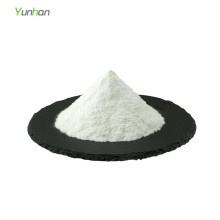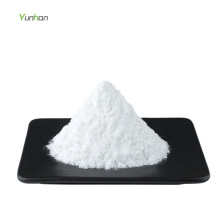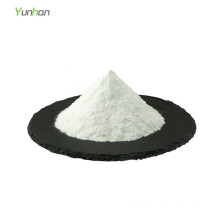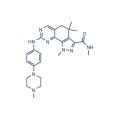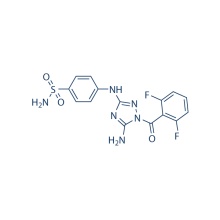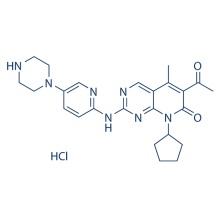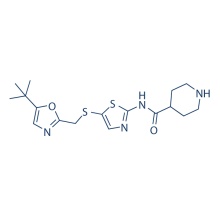Milciclib (PHA-848125) 802539-81-7
Product Description
.cp_wz table {border-top: 1px solid #ccc;border-left:1px solid #ccc; } .cp_wz table td{border-right: 1px solid #ccc; border-bottom: 1px solid #ccc; padding: 5px 0px 0px 5px;} .cp_wz table th {border-right: 1px solid #ccc;border-bottom: 1px solid #ccc; padding: 5px 0px 0px 5px;}
Molecular Weight:
460.57 Milciclib (PHA-848125) is a potent, ATP-competitive CDK Inhibitor for CDK2 with IC50 of 45 nM. It is >3-fold more selective for CDK2 than CDK1, 2, 4, 5, and 7. Phase 2.
Biological Activity
PHA-848125 inhibits, although with lower potency, the activities of
cyclin H/CDK7, cyclin D1/CDK4, p35/CDK5, as well as cyclin E/CDK2 and
cyclin B/CDK1 with IC50 values of 0.15, 0.16, 0.265, 0.363, 0.398 μM,
respectively. Thropomyosin receptor kinase A is also inhibited by
PHA-848125 in the same nanomolar range as CDKs. In the most
PHA-848125-sensitive cell line, PHA-848125 induces a
concentration-dependent G(1) arrest. PHA-848125 also impairs
phosphorylation of the retinoblastoma protein at CDK2 and CDK4 specific
sites, reduces retinoblastoma protein and cyclin A levels, and increases
p21(Cip1), p27(Kip1) and p53 expression.
PHA-848125 is added to the
cells 48 h after TMZ and cell growth is evaluated after 3 additional
days of culture. A drug combination of TMZ, BG and PHA-848125 induces
an additive or synergistic effect on cell growth, depending on the cell
line. In the absence of BG, the combination is still more active than
the single agents in cell lines moderately sensitive to TMZ, but
comparable to PHA-848125 alone in the two TMZ-resistant cell lines. When
TMZ plus BG are used in combination with PHA-848125 against cultured
normal melanocytes, neither synergistic nor additive antiproliferative
effects are observed.
In the preclinical xenograft A2780 human ovarian carcinoma model,
PHA-848125 reveals good efficacy and is well tolerated upon repeated
daily treatments. Treatment of K-Ras(G12D)LA2 mice with PHA-848125 (40
mg/kg twice daily for 10 days) results in significant tumor growth
inhibition at the end of the treatment and is accompanied by a reduction
in the cell membrane turnover. On the other hand, following oral
administration, PHA-848125 shows significant antitumor activity in
various human xenografts, carcinogen-induced tumors and in disseminated
primary leukemia models; the plasma concentrations in rodents being in
the same range as those found inhibiting cancer cell proliferation.
Protocol(Only for Reference)
Kinase Assay: [4]
Cell Assay: [1]
Animal Study: [3]
Conversion of different model animals based on BSA (Value based on data from FDA Draft Guidelines)
For example, to modify the dose of resveratrol used for a mouse (22.4 mg/kg) to a dose based on the BSA for a rat, multiply 22.4 mg/kg by the Km factor for a mouse and then divide by the Km factor for a rat. This calculation results in a rat equivalent dose for resveratrol of 11.2 mg/kg.
Chemical Information
Molarity Calculator
Dilution Calculator
Molecular Weight Calculator
Contact us if you need more details on 802539-81-7. We are ready to answer your questions on packaging, logistics, certification or any Other aspects about Milciclib 802539-81-7、PHA-848125 802539-81-7. If these products fail to match your need, please contact us and we would like to provide relevant information.
Molecular Weight:
460.57 Milciclib (PHA-848125) is a potent, ATP-competitive CDK Inhibitor for CDK2 with IC50 of 45 nM. It is >3-fold more selective for CDK2 than CDK1, 2, 4, 5, and 7. Phase 2.
Biological Activity
PHA-848125 inhibits, although with lower potency, the activities of
cyclin H/CDK7, cyclin D1/CDK4, p35/CDK5, as well as cyclin E/CDK2 and
cyclin B/CDK1 with IC50 values of 0.15, 0.16, 0.265, 0.363, 0.398 μM,
respectively. Thropomyosin receptor kinase A is also inhibited by
PHA-848125 in the same nanomolar range as CDKs. In the most
PHA-848125-sensitive cell line, PHA-848125 induces a
concentration-dependent G(1) arrest. PHA-848125 also impairs
phosphorylation of the retinoblastoma protein at CDK2 and CDK4 specific
sites, reduces retinoblastoma protein and cyclin A levels, and increases
p21(Cip1), p27(Kip1) and p53 expression.
PHA-848125 is added to the
cells 48 h after TMZ and cell growth is evaluated after 3 additional
days of culture. A drug combination of TMZ, BG and PHA-848125 induces
an additive or synergistic effect on cell growth, depending on the cell
line. In the absence of BG, the combination is still more active than
the single agents in cell lines moderately sensitive to TMZ, but
comparable to PHA-848125 alone in the two TMZ-resistant cell lines. When
TMZ plus BG are used in combination with PHA-848125 against cultured
normal melanocytes, neither synergistic nor additive antiproliferative
effects are observed.
In the preclinical xenograft A2780 human ovarian carcinoma model,
PHA-848125 reveals good efficacy and is well tolerated upon repeated
daily treatments. Treatment of K-Ras(G12D)LA2 mice with PHA-848125 (40
mg/kg twice daily for 10 days) results in significant tumor growth
inhibition at the end of the treatment and is accompanied by a reduction
in the cell membrane turnover. On the other hand, following oral
administration, PHA-848125 shows significant antitumor activity in
various human xenografts, carcinogen-induced tumors and in disseminated
primary leukemia models; the plasma concentrations in rodents being in
the same range as those found inhibiting cancer cell proliferation.
Protocol(Only for Reference)
Kinase Assay: [4]
| Biochemical kinase inhibition assays | Inhibition of kinase activity by PHA-848125 is assessed using a strong anion exchanger (Dowex 1X8 resin)–based assay in robotized format run on 384-well plates. In this assay, specific peptides or protein substrates are transphosphorylated by their specific kinase in the presence of ATP traced with [γ-33P]ATP using optimal buffers and cofactors. The potency of PHA-848125 toward CDKs and 38 additional kinases belonging to an in-house Kinase Selectivity Screening panel is evaluated, and the relevant IC50s are determined. For each enzyme, the absolute KM values for ATP and the specific substrate are calculated and each assay is then run at optimized ATP (2KM) and substrate (5KM) concentrations. This setting enables direct comparison of IC50 values of PHA-848125 across the panel for evaluation of its biochemical profile. |
|---|
Cell Assay: [1]
| Cell lines | Melanoma cells |
|---|---|
| Concentrations | 5.7 mg/mL |
| Incubation Time | 2 hours |
| Method | Melanoma cells are suspended in culture media at a concentration of 2 × 104 cells/mL, dispensed in 50 μL aliquots into flat-bottom 96-well plates and allowed to adhere overnight at 37 °C. Graded amounts of PHA-848125 or TMZ are then added to the wells (4 wells per point) in 50 μL of CM and the plates are incubated at 37 °C in a 5% CO2 humidified atmosphere for 5 days. The cytotoxic effects of TMZ are also evaluated in combination with the MGMT inhibitor BG. To this end, 10 μM BG is added to the plates 2 hours before TMZ and left in culture for the entire period of cell exposure to the drug. ContS1017rol groups are represented by untreated cells and cells treated with BG or DMSO alone. The growth of the cells treated with BG or DMSO alone does not differ from that of untreated cells. MGMT activity of BG-treated cells is undetectable 2 hours after the addition of the inhibitor PHA-848125 and remained essentially undetectable up to the end of the assay. Normal melanocytes are suspended in MGM at the concentration of 1.6 × 105 cells/mL, plated (50 μL/well) and exposed to TMZ + BG or to PHA-848125 as described for melanoma cells. At the end of the incubation period, cell growth is evaluated by the MTT assay. Briefly, 0.1 mg of MTT (in 20 μL of PBS) is added to each well and cells are incubated at 37 °C for 4 hours. Cells are then lysed with a buffer (0.1 mL/well) containing 20% SDS and 50% N,N-dimethylformamide, pH 4.7. After overnight incubation, the absorbance is read at 595 nm using a 3550-UV microplate reader. Cell sensitivity to drug treatment is expressed in terms of IC50 (drug concentration producing 50% inhibition of cell growth, calculated on the regression line in which absorbance values at 595 nm are plotted against the logarithm of drug concentration). |
Animal Study: [3]
| Animal Models | K-Ras(G12D)LA2 mice | ||
|---|---|---|---|
| Formulation | 5% dextrose solution | ||
| Dosages | 40 mg/kg twice daily for 10 days | ||
| Administration | Oral administration | ||
| Solubility | 30% propylene glycol, 5% Tween 80, 65% D5W, 30 mg/mL | ||
| * Please note that Selleck tests the solubility of all compounds in-house, and the actual solubility may differ slightly from published values. This is normal and is due to slight batch-to-batch variations. | |||
Conversion of different model animals based on BSA (Value based on data from FDA Draft Guidelines)
| Species | Baboon | Dog | Monkey | Rabbit | Guinea pig | Rat | Hamster | Mouse |
| Weight (kg) | 12 | 10 | 3 | 1.8 | 0.4 | 0.15 | 0.08 | 0.02 |
| Body Surface Area (m2) | 0.6 | 0.5 | 0.24 | 0.15 | 0.05 | 0.025 | 0.02 | 0.007 |
| Km factor | 20 | 20 | 12 | 12 | 8 | 6 | 5 | 3 |
| Animal A (mg/kg) = Animal B (mg/kg) multiplied by | Animal B Km |
| Animal A Km |
For example, to modify the dose of resveratrol used for a mouse (22.4 mg/kg) to a dose based on the BSA for a rat, multiply 22.4 mg/kg by the Km factor for a mouse and then divide by the Km factor for a rat. This calculation results in a rat equivalent dose for resveratrol of 11.2 mg/kg.
| Rat dose (mg/kg) = mouse dose (22.4 mg/kg) × | mouse Km(3) | = 11.2 mg/kg |
| rat Km(6) |
Chemical Information
| Molecular Weight (MW) | 460.57 |
|---|---|
| Formula | C25H32N8O |
| CAS No. | 802539-81-7 |
| Storage | 3 years -20℃Powder |
|---|---|
| 6 months-80℃in solvent (DMSO, water, etc.) | |
| Synonyms | |
| Solubility (25°C) * | In vitro | DMSO | 92 mg/mL (199.75 mM) |
|---|---|---|---|
| Water | <1 mg/mL ( | ||
| Ethanol | <1 mg/mL ( | ||
| In vivo | 30% propylene glycol, 5% Tween 80, 65% D5W | 30 mg/mL | |
| * <1 mg/ml means slightly soluble or insoluble. * Please note that Selleck tests the solubility of all compounds in-house, and the actual solubility may differ slightly from published values. This is normal and is due to slight batch-to-batch variations. | |||
| Chemical Name | N,1,4,4-tetramethyl-8-(4-(4-methylpiperazin-1-yl)phenylamino)-4,5-dihydro-1H-pyrazolo[4,3-h]quinazoline-3-carboxamide |
|---|
Molarity Calculator
Dilution Calculator
Molecular Weight Calculator
Contact us if you need more details on 802539-81-7. We are ready to answer your questions on packaging, logistics, certification or any Other aspects about Milciclib 802539-81-7、PHA-848125 802539-81-7. If these products fail to match your need, please contact us and we would like to provide relevant information.
Product Categories : Cell Cycle > CDK Inhibitor
Other Products
Hot Products
Astragaloside AChlortetracycline HCl 64-72-2Paclitaxel 33069-62-4Dexamethasone Acetate 1177-87-3Dinaciclib (SCH727965) 779353-01-4CHIR-124 405168-58-3Ro3280 1062243-51-9TAME 901-47-3CCG-1423 285986-88-110058-F4 403811-55-2Dabigatran (BIBR 953) 211914-51-1H 89 2HCl 130964-39-5T0901317 293754-55-9Aprepitant 170729-80-3Turofexorate Isopropyl (XL335) 629664-81-9BMS-378806 357263-13-9
